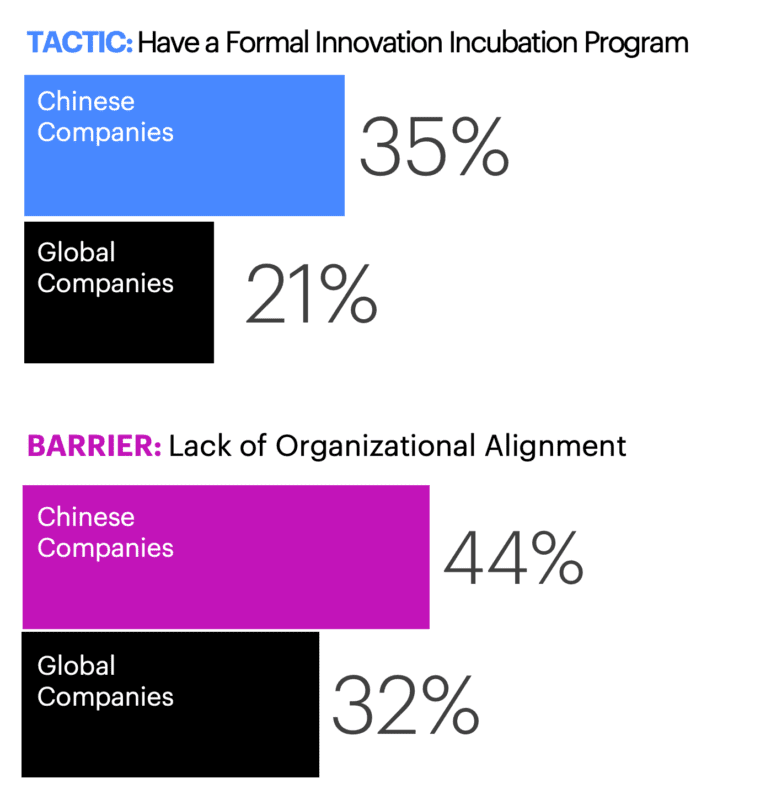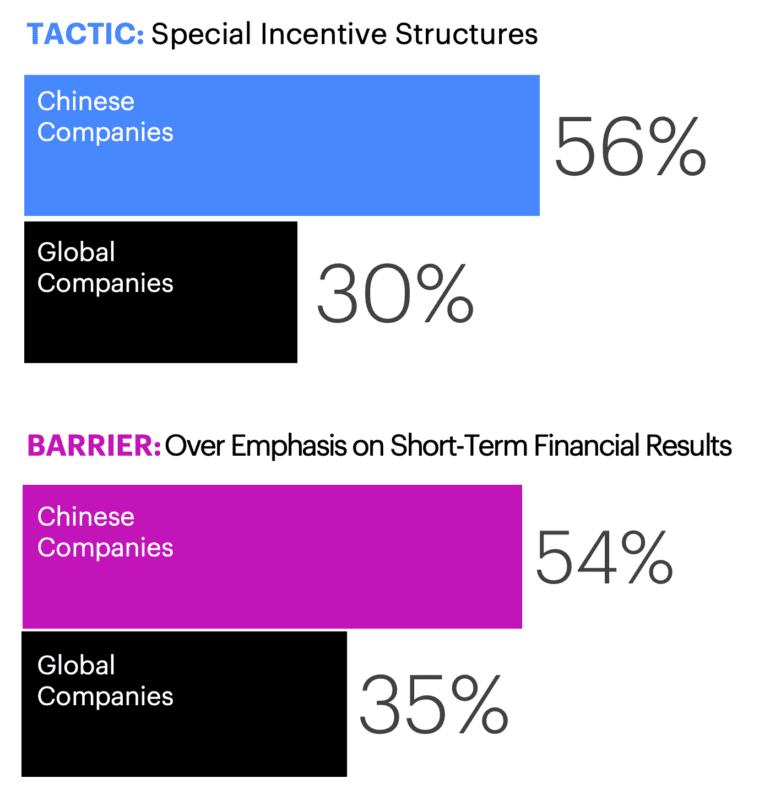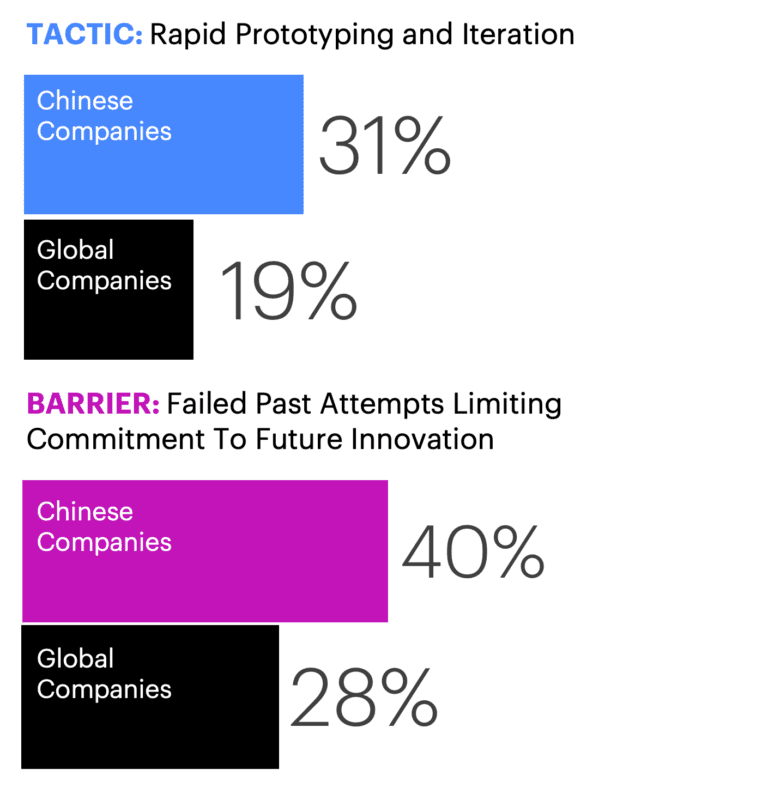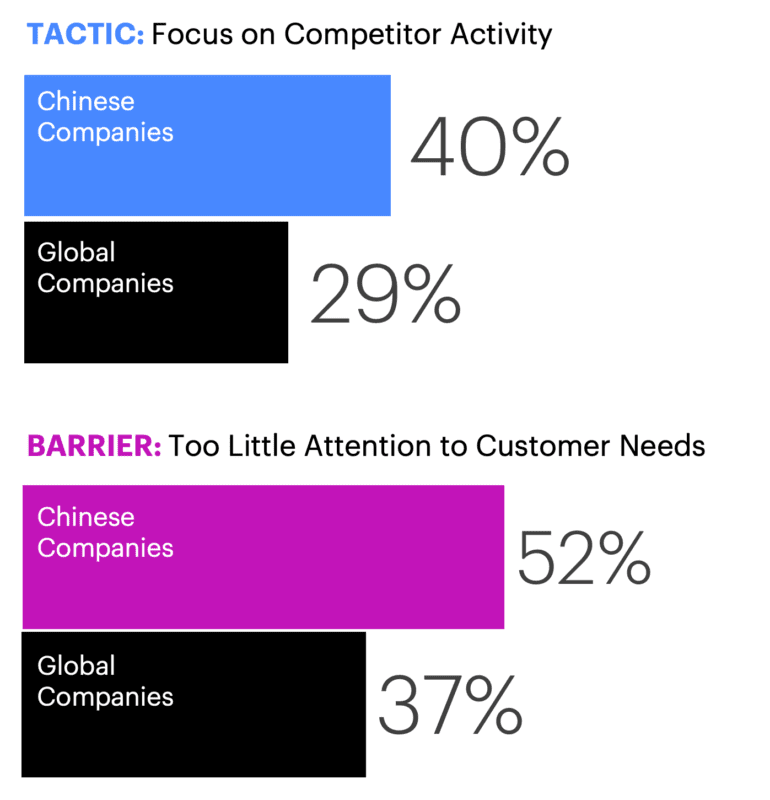BLOG
Connecting the Dots Between Innovation and Resilience: 4 Learnings for Companies in China
Companies in China believe innovation and resilience are connected but they experience strong tension. Read more on how to overcome barriers.
Investing in both innovation and organizational resilience are two essential elements of success for companies to compete in today’s rapidly changing world. Through interviews with 14 senior executives and surveying 300+ innovation experts across the globe, Prophet’s latest research explores how successful organizations use innovation to drive business resilience.
Four Learnings for Companies in China to Build Innovative Organizations
Our findings reveal that innovative companies are more likely to be resilient. Particularly, 60% of respondents in China agree that innovation and resilience are connected, more so than their counterparts in Singapore (48%), the U.S. (47%) and the UK (47%). However, there exists a strong tension between the two characteristics – while Chinese companies on average deploy more innovation tactics compared to companies globally, they also face more pronounced barriers. In this article, we share our key findings and explore implications for Chinese businesses seeking to drive sustainable growth through innovation.
1. Prioritize Cross-Functional Alignment
Incubation programs and pod-like team structures have long proven to be effective innovation tactics and are widely adopted by companies in China. According to our research, 35% of Chinese respondents report that their companies have a formal innovation incubation program compared to 21% of respondents globally. Additionally, 27% of Chinese respondents report their companies use pod-like team structures vs. just 18% of respondents globally. However, such team structures risk becoming siloed. A lack of cross-functional alignment remains a significant barrier to innovation and growth, with 44% of Chinese respondents citing it as a challenge compared to only 32% globally.

One example of how cross-functional alignment can impact innovation comes from the fast-growing beverage brand Chi Forest. As a startup, the company found tremendous success through operational agility, running pod-like teams with product managers in each team leading individual innovation initiatives. However, as Chi Forest grew, organizational inefficiencies emerged due to a lack of streamlined workflows and cross-functional collaboration, causing an overlap of roles and processes. Chi Forest has embarked on an organization-wide transformation agenda to reimagine its operation and business model.
Takeaway: It is important to implement innovation incubation programs and pod-like team structures, while also emphasizing cross-functional alignment.
2. Develop Balanced Innovation Incentive Structures
Incentives are a crucial part of driving innovation, but overly focusing on short-term financial outcomes can hinder success. Our findings show that 56% of Chinese respondents report their companies to have special incentive structures for new business opportunities compared to 30% globally. Yet this has also led to an innovation barrier, where 54% of Chinese respondents say their companies have too much emphasis on short-term financial results compared to 35% globally.

To empower long-term growth for the company, innovation success should be measured against various objectives beyond financial ROI. For example, Xiaomi has a series of incentive programs to encourage innovation, including an Annual Technology Award that rewards $1 million to an internal engineering project every year, evaluating technology and engineering excellence as well as business impact. The 2022 winner, Xiaomi’s CyberDog team, impressed CEO Lei Jun because the project successfully integrated many of the group’s R&D results and presented new technologies that could be soon applied to other core products. This is a good example of how incentives can be used effectively to drive impactful innovation.
On the other hand, companies like Pop Mart are facing growing pains. Although the company offers generous incentives, it measures innovation success solely on the creation of new product lines and their short-term sales volumes. As a result, the toy maker is left with a bloated portfolio and hasn’t been able to elevate its brand equity despite years of exponential growth.
Takeaway: To avoid pitfalls, organizations must develop incentive structures to recognize results, while avoiding overly focusing on short-term financial outcomes.
3. Guide Rapid Innovation Cycles with Long-Term Vision
Rapid prototyping and iteration is a common innovation tactic, but past innovation failures and a lack of long-term planning processes can discourage innovation. Our findings show that 31% of respondents in China say their companies use rapid prototyping and iteration compared to just 19% of respondents globally. However, failed past attempts at innovation have limited commitment to future innovation for 40% of Chinese companies compared to 28% globally. Additionally, 40% of Chinese respondents say their companies lack a long-term planning process compared to 38% globally.

Shiseido’s approach to innovation is a great example of how companies can balance a strong brand vision and rapid innovation cycles. “Shiseido’s ability to have lasting success is in large part due to our dedication to creating the best quality products to meet consumer needs. This dedication to ‘craftsmanship’ is why we don’t blindly follow market trends but rather think critically about how we can further refine our products,” said Carol Zhou, SVP of China Business Innovations & Investments at Shiseido, in an interview with Prophet, “Although we may not always be at the forefront of trends, we have found the right pace to create a timeless brand.”
Takeaway: Organizations should lead innovations with a clear vision and long-term planning, while enabling rapid prototyping and iteration based on a clear strategic roadmap, to create products that meet both long-term and short-term goals.
4. Focus on Customer Insights as a Foundation of Innovation
Creating differentiating innovations and finding emergent subcategories are effective ways to separate yourself from competitors, but paying too much attention to competitors and too little attention to customer needs is a surprisingly common mishap, according to our research. Chinese companies tend to focus heavily on competitor activity, with 40% doing so compared to 29% globally. This is often at the expense of paying attention to the needs of their customers, with 52% of Chinese respondents reporting that a major barrier to innovation for their companies is paying too little attention to customer needs, compared to 37% globally.

Companies must develop an organizational-wide mindset of diving into customer insights, data analysis, and user testing to identify what customers truly need and want. By doing so, they can create innovative products and services that truly differentiate them from their competitors, making them stand out in the market. Nike has been successful in this regard, with a strong focus on the athlete and understanding their needs driving their innovations. As Mark Parker, CEO of Nike, explains, “Our success has been based on our commitment to innovation and great design, which really in our case starts with our commitment to the athlete – and really understanding the athlete and the insights we get from that relationship. So, we translate those insights into real innovation.” In China, Nike actively deploys a localized digital ecosystem to engage with its customers and understand their needs. In turn, the rich data gathered from these digital platforms continuously fuels its innovation and growth.
Takeaway: Prioritize a human-centered approach that focuses on customer needs to create truly meaningful innovations.
Building Innovative Organizations
Indeed, innovation is not a department, but a collective achievement of an organization, as one innovation leader has told us. Companies should lead with a vision, encourage risk-taking, experimentation, and collaboration across all levels of the organization. This will help to create an environment where innovation can thrive and become ingrained in the company’s DNA.
What can your company do today to turbocharge innovation?
- Emphasize the importance of always-on consumer insights and deploy the right team and structure as enablement.
- Ensure a holistic view of the market demand landscape, covering both consumers and competition and strategize growth moves and innovation efforts.
- Build a multi-year roadmap with different chapters and cross-functional teams and land the detailed action plan in a short-term/ one-year plan.
- Clarify how innovation initiatives drive business purpose, develop employee value propositions and define incentives accordingly.
- Transform how your innovation team works within your organization to instill agility and collaboration.
FINAL THOUGHTS
Innovation and organizational resilience go hand-in-hand. Combined with investing in diverse innovation tactics, driving C-suite buy-in, and creating an organizational-wide innovation culture, businesses are more likely to be innovative and resilient, and become more likely to have greater financial success.
Our research shows that Chinese companies excel in deploying innovation tactics compared to companies globally, however they also under-invest in building long-term resilience. It is crucial for them to close this gap in order to drive transformative growth that’s meaningful and sustainable.


